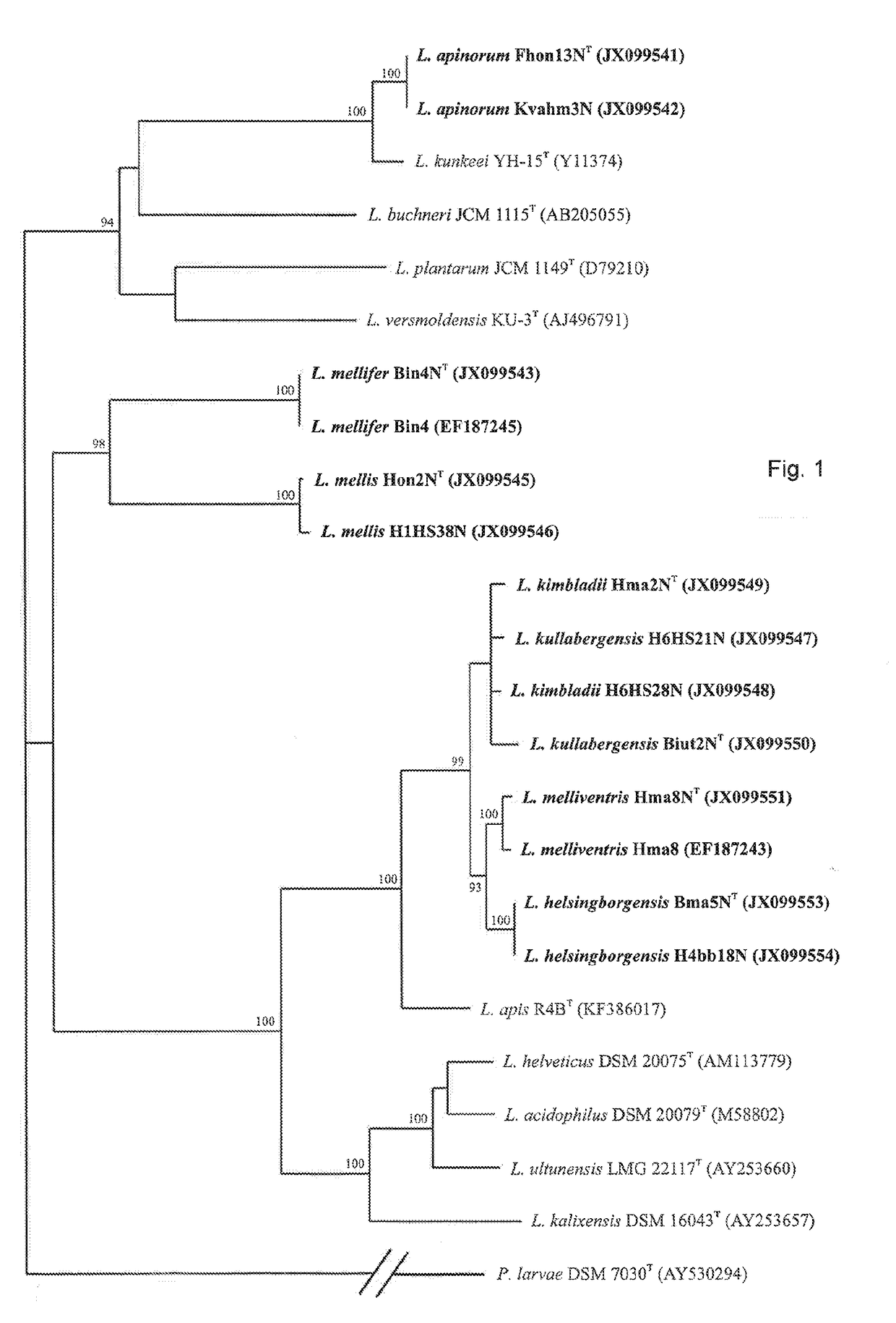Lactobacillus apinorum and lactobacillus mellifer from honeybees in medical, food and feed applications
a technology of lactobacillus and lactobacillus, which is applied in the field of lactobacillus apinorum and lactobacillus mellifer from honeybees in medical, food and feed applications, and can solve the problems of the destruction of infected colonies in many countries
- Summary
- Abstract
- Description
- Claims
- Application Information
AI Technical Summary
Benefits of technology
Problems solved by technology
Method used
Image
Examples
example 1
enzene Derivatives Against Wax Moth
[0077]When chemicals are used to fight of different bee diseases in the hive it is always a fine balance between using sufficient to kill off the pathogen / parasite and not killing off the bees themselves. A treatment, which was in common use and advised in older books, killing off the wax moth larvae, was the use of para dichlorobenzene (PDB) crystals. This moth deterrent was extremely effective but the chemical can accumulate in the wax and possibly damage bee larvae and contaminate honey. Therefore it is no longer acceptable to use it (Leaflet from The British Beekeepers Association—July 2012). We wanted to find out if the two Lactobacillus strains originating in honeybees produce any kind of benzene derivatives and in natural amounts helping the bees fighting of the wax moth larvae or preventing attack from it.
[0078]Table 1
TABLE 1Bioactive substances produced by each of the two strains from honeybees(A. mellifera). The table depicts volatiles (b...
example 2
nd Pathogens
[0080]The inhibitory effect against severe multidrug-resistant pathogens from chronic wound infections was tested (Olofsson, T. C., et al. Accepted for publication in International Wound Journal, July 2014). Used pathogens (Table 2) were cultivated in Nutrient broth (Oxoid) at 37° C. during 24 hours prior to test in the antagonism assays.
[0081]Antimicrobial activity was measured by using dual culture overlay assay. The Lactobacillus apinorum and Lactobacillus mellifer strains (Table 2) were put into a filter disk and placed onto supplemented MRS agar plates followed by overnight incubation at 35° C. Table 2
TABLE 2The diameters of the inhibition zones are displayed in millimetres. Antibioticscommonly used against the same pathogens are depicted as controls.Table 2. Dual culture overlay assays with LAB strains of bee origin against clinical isolates ofpathogenic wound bacteria and yeast. The diameters of the inhibition zones are displayed inmillim...
example 3
y Acids 3-OH
[0085]Certain species within LAB may produce bioactive compounds such as free fatty acids (3-OH) that are inhibitory against pathogens. We tested if either of the two strains produce 3-OH and if it is possible to find these bacterial metabolites in honey produced by honeybees using these strains (Olofsson, T. C., et al. Accepted for publication in International Wound Journal, July 2014).
[0086]The LAB species were grown in 5 ml supplemented MRS and 5 ml Pollen media until they reached their early stationary phase, after approx. 24 hours of incubation at 35° C. (13). Three millilitres of the supernatant was filtered through a 0.20 μm filter (Sarstedt). The filtered supernatants were freeze-dried during 18 hours at −20° C. before the GC-MS analysis.
[0087]The freeze-dried bacterial supernatants, and both stored and fresh harvested honey samples (200 mg), were analyzed for 3-OH FAs. In brief, the preparations were heated in acid methanol, extracted with heptane, and purified ...
PUM
| Property | Measurement | Unit |
|---|---|---|
| water content | aaaaa | aaaaa |
| temperature | aaaaa | aaaaa |
| temperature | aaaaa | aaaaa |
Abstract
Description
Claims
Application Information
 Login to View More
Login to View More - R&D
- Intellectual Property
- Life Sciences
- Materials
- Tech Scout
- Unparalleled Data Quality
- Higher Quality Content
- 60% Fewer Hallucinations
Browse by: Latest US Patents, China's latest patents, Technical Efficacy Thesaurus, Application Domain, Technology Topic, Popular Technical Reports.
© 2025 PatSnap. All rights reserved.Legal|Privacy policy|Modern Slavery Act Transparency Statement|Sitemap|About US| Contact US: help@patsnap.com

